Haunted Thrills – American Pre-code Horror Comics. Full translation from the 2021 documentary by Mike T. Lyddon and Reel Progress LLC in conjunction with Ghost Clinic Films. Watch Haunted Thrills on the Horror Mike Channel.
The late 1940’s and early 1950’s saw a new kind of comic book emerge on America’s newsstands. World War Two was over and superheroes had lost their popularity, so the genres of crime, science fiction, western, romance, and most importantly, horror, took their place on the nation’s magazine racks.
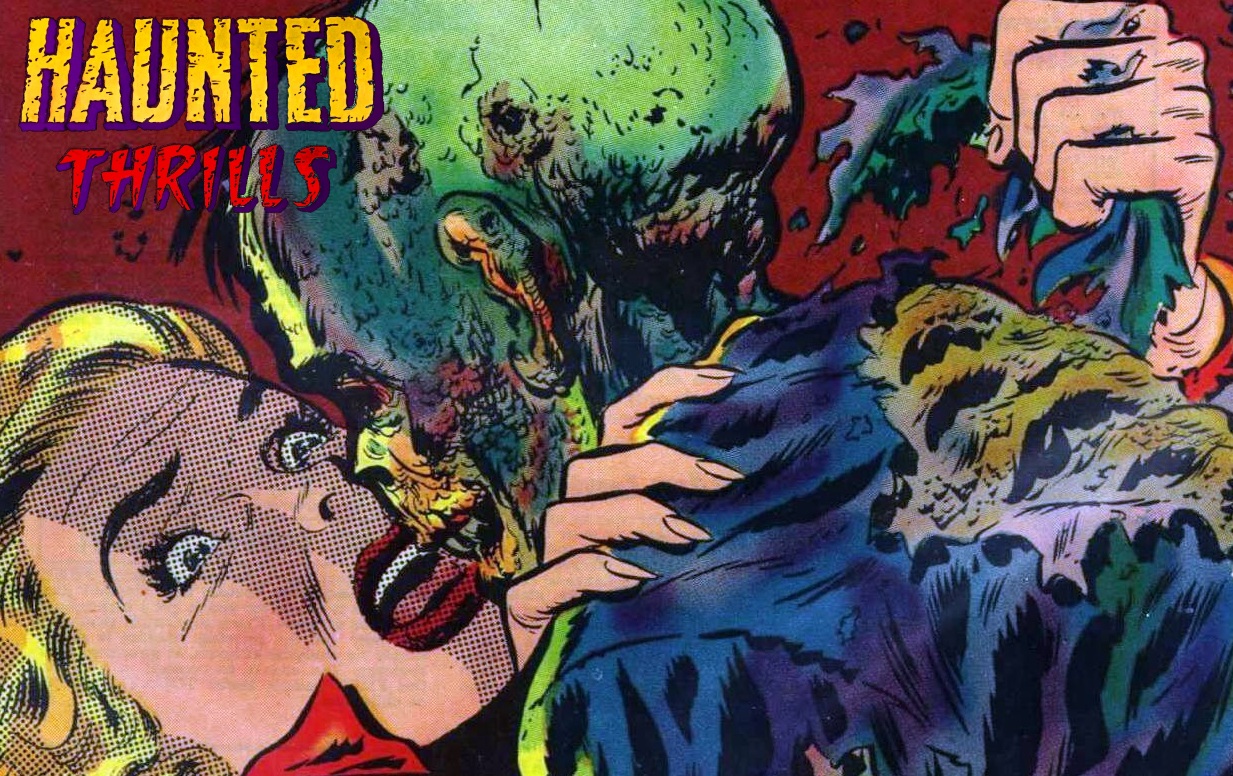
PRE-CODE HORROR COMIC BOOK ORIGINS
In 1947, Avon Books put out one all horror anthology style comic book called EERIE. It was the first of it’s kind, and led to a deluge of horror comics beginning in 1949 with AMERICAN COMICS GROUP’s first title – ADVENTURES INTO THE UNKNOWN. Soon dozens of publishers including EC, ATLAS, FAWCETT, STAR PUBLICATIONS AND MANY MORE would flood the shelves with terrifying tales in four colors.
But it would all come to an abrupt end at the end of 1954 when, after public outcry and government intervention, The Comics Code Authority was imposed upon the publishers forcing many out of business and destroying the livelihoods of numerous artists and writers.
This essay is a celebration of the publishers, artists, and writers who made their immortal contributions to the gruesome, horrific and sometimes hilarious 10 cent tales of the pre-code horror comics era.
Part One: The earth trembles!
New York City, 1948. Comic book artist supreme Sheldon Moldoff approached Fawcett Publications with two pre-packaged titles – This Magazine Is Haunted and Tales of the Supernatural. They weren’t interested in horror at the time, so Moldoff signed a deal with William Gaines. A few months later, Gaines emerged with EC Comics, completely reneging on the contract he previously signed with Moldoff. According to Moldoff, Gaines’ attorney threatened to have him blacklisted if he tried to sue Gaines.
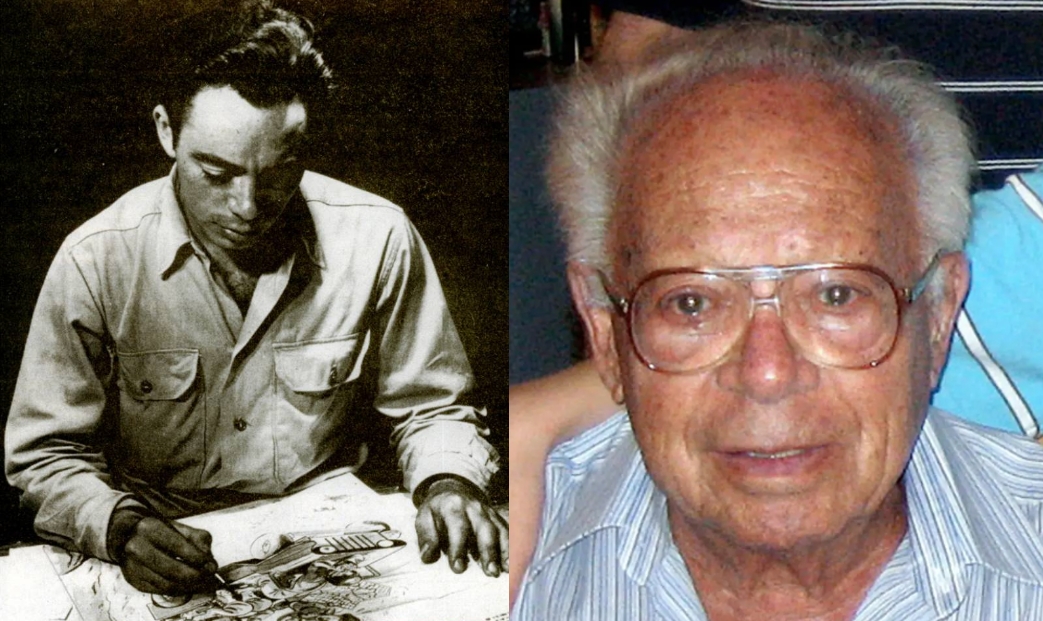
Comic Book artist Sheldon Moldoff
Despite being shafted by Gaines, Moldoff returned to Fawcet. They ran with the horror comics, and Shelly Moldoff contributed many great stories to THIS MAGAZINE IS HAUNTED, WORLDS OF FEAR, BEWARE! TERROR TALES, and more.
But even before EC Comics hit the stands, AMERICAN COMICS GROUP started what would be the longest horror comics run in history. ADVENTURES INTO THE UNKNOWN, starting in October of 1948 and spanning two decades to August, 1967 with a whopping 174 issues, the first 61 issues published in the pre-code era.
Another key player in the early pre-code horror days was ATLAS COMICS, with none other than STAN LEE at the helm as editor-in-chief working out of the Empire State Building in New York City. ATLAS would also beat EC to the punch with AMAZING MYSTERIES first issue published in May of 1949.
Soon after American Comics Group, ATLAS and EC began publishing horror comics, dozens of other publishers jumped into the fray. Many titles hit the newsstands every month, and in some cases the newcomers left their predecessors far behind.
Part two: The Publishers
Avon, Charlton, Fawcett, Stanley Morse, Harvey, DC, Ajax-Farrell, Star Publications, Quality Comics and more. By the end of 1951, dozens of publishers were churning out horror comics at a frightening pace. Newsstands were wall to wall with often gruesome and suggestive crime and horror comics causing outrage across the land.
Stanley Morse was famous, or should I say, infamous, for publishing WEIRD MYSTERIES, MISTER MYSTERY, WEIRD CHILLS and WEIRD TALES OF THE FUTURE among others. He once said that he didn’t give a damn what kind of stories were in the comics as long as they sold. This gave the artists and writers freedom to create some of the most extreme envelope pushing comics of the pre-code era. Needless to say, these are highly priced, sought after comics with prices reaching well into the thousands of dollars for higher grade copies.
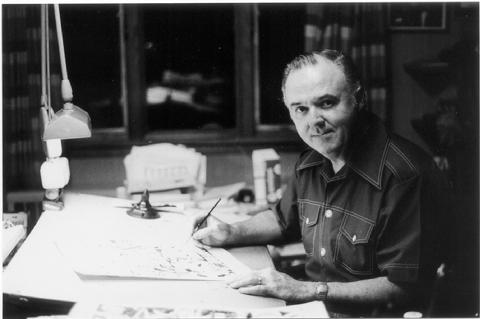
Joe Sinnott – Atlas pre-code comic book artist
But Morse wasn’t the only one with loose reigns. Over at Atlas Comics, Stan Lee gave plenty of slack to the artists and writers.
One of the most famous Atlas and Marvel artists who worked for Stan Lee is Joltin’ Joe Sinnott, who began his tenure at Atlas in 1951.
Sinnott recalls working for Atlas and Stan Lee. “I’d go down the empire state building with my five or six page story and Stan would be behind his desk on his typewriter and he had a stack of scripts. He would tell you just what he wanted in each panel but you didn’t necessarily have to follow them you if you thought something else would make a better picture, you could do it your way.”
Part three: The Artists
While Avon published what is considered the first horror comic book in 1947, they did not resume publishing Eerie until the early 50’s. With an impressive arsenal of artists including Wally Wood, A.C. Hollingsworth, Moe Marcus, Fred Kida, Sid Check, Carmine Infantino and many others, one of the stand outs in their stable of science fiction and horror was the great Everett Raymond Kinstler, who recalled working for Avon.
Kinstler and Avon Comics
“The editor then was a man named Saul Cohen. I’m talking now about probably getting close to 1950. He gave me total freedom, and that, I can’t tell you what that meant to me.
I had no guidelines at all or restrictions. They would say to me, Ray, we’re doing Eerie comics and such, here are the stories that are going in there i’d look through them and I take things that i thought would illustrate them and never once did Saul say ‘take this out or put this in or change this’ and of course that’s all most of us were used to were corrections.”
Kinstler drew a great number of War, Romance and Western comics for Avon, but his work in the pages of Eerie, Phantom Stranger, Witchcraft, Strange Worlds and other Avon titles were truly stunning.
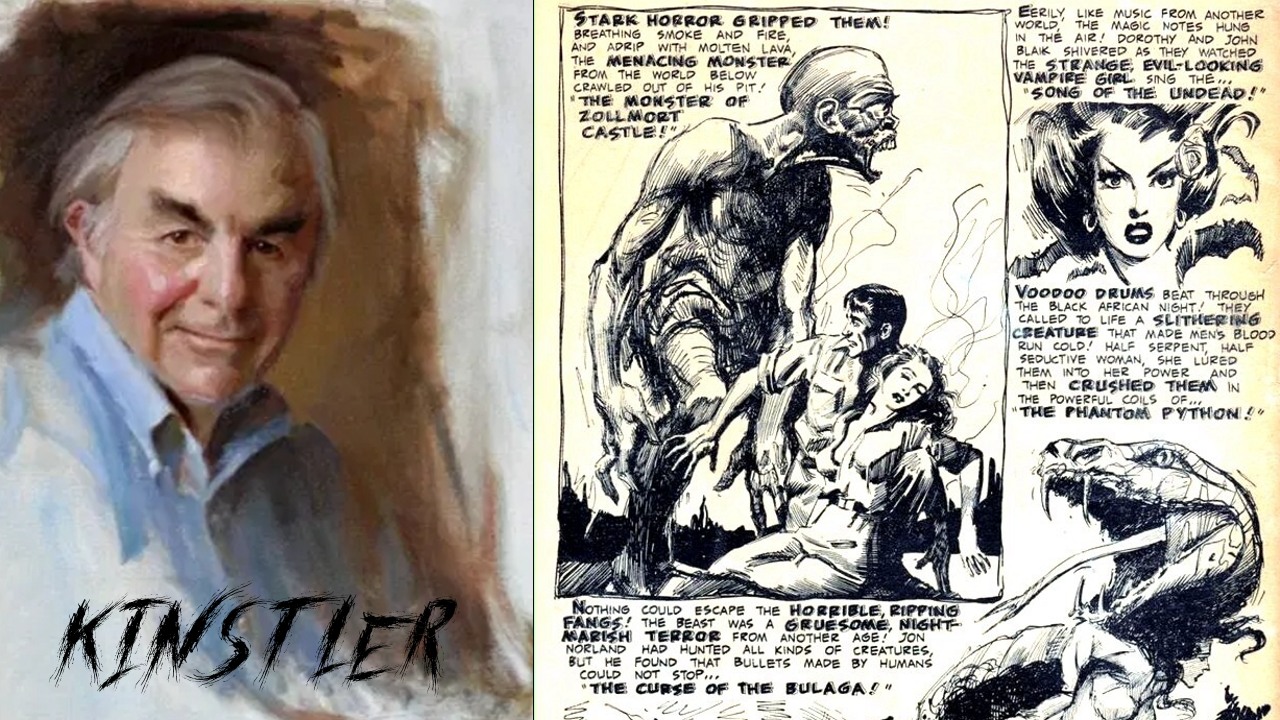
Everett Raymond Kinstler
Kinstler’s Line Art
Some of my personal favorites are the amazing black and white illustrated index pages he did for Eerie.
Kinstler recounts doing those amazing line art pages. “By doing the black and whites i had total freedom and total clarity of first class reproduction whereas with the color comic book pages when i would do the same, let’s say the same technique, it would become a little bit blurred a little bit blotted then the color would go on top of it which would be like taking a gear shift and losing one gear.”
Kinstler also drew a fine adaptation of Edgar Allan Poe’s “Pit and the Pendulum” for Ziff Davis in their intriguing but short lived run of Nightmare.
His fine line art serves the mood of Poe’s grim and suspenseful tale very well.
Everett Raymond Kinstler passed away in 2019 at the age of 93.
Joe Sinnott
Joe Sinnott drew many horror and science fiction stories for Atlas titles like Adventures into Terror, Astonishing, Marvel Tales, Menace, Journey into Mystery, Strange Tales, Uncanny Tales and others.
“The first story I drew for Atlas was a western called ‘The Man who wouldn’t Die.’ It was a three page filler for one of the western comics and I’ve been working for Stan ever since.”
Joe drew a lot of great stories for Atlas including “Behind the Door” in Spellbound #16, the tale of A wealthy old man who builds a viewing device so powerful that he can see Death coming for him.
Lovecraftian Stories in Atlas Comics
For Astonishing #11, he contributed a Lovecraftian story called “The Last of Mr. Mordeau” about a man who discovers a devolved family of sorcerers living under his castle.
He drew a particularly nice story for Strange Tales #9 called “Drink Deep, Vampire,” about a business man who tries to swindle a coven of vampires by draining their blood every day and selling it back to them at night.
Sadly, we lost Joe in 2020, but his legacy will remain in the hearts and minds of comic book fans forever.
Victor Carrabotta
Golden Age comics artist Victor Carrabotta drew many pre-code horror and western stories for Atlas and has fond memories of his tenure there and a great story about Jack Kirby and Stan Lee.
“Jack was looking at my work and then he stepped out to the lobby and my wife was sitting there and she stood up. I said this is my wife and as he looked at her he kind of gave her a double look you know up and down he says my gosh she’s pregnant. He said “This poor guy needs a job and he says just wait a minute. Let me go back into my little cubby hole and i want to write a letter that you could bring to Stan Lee. I never knew what was in it.
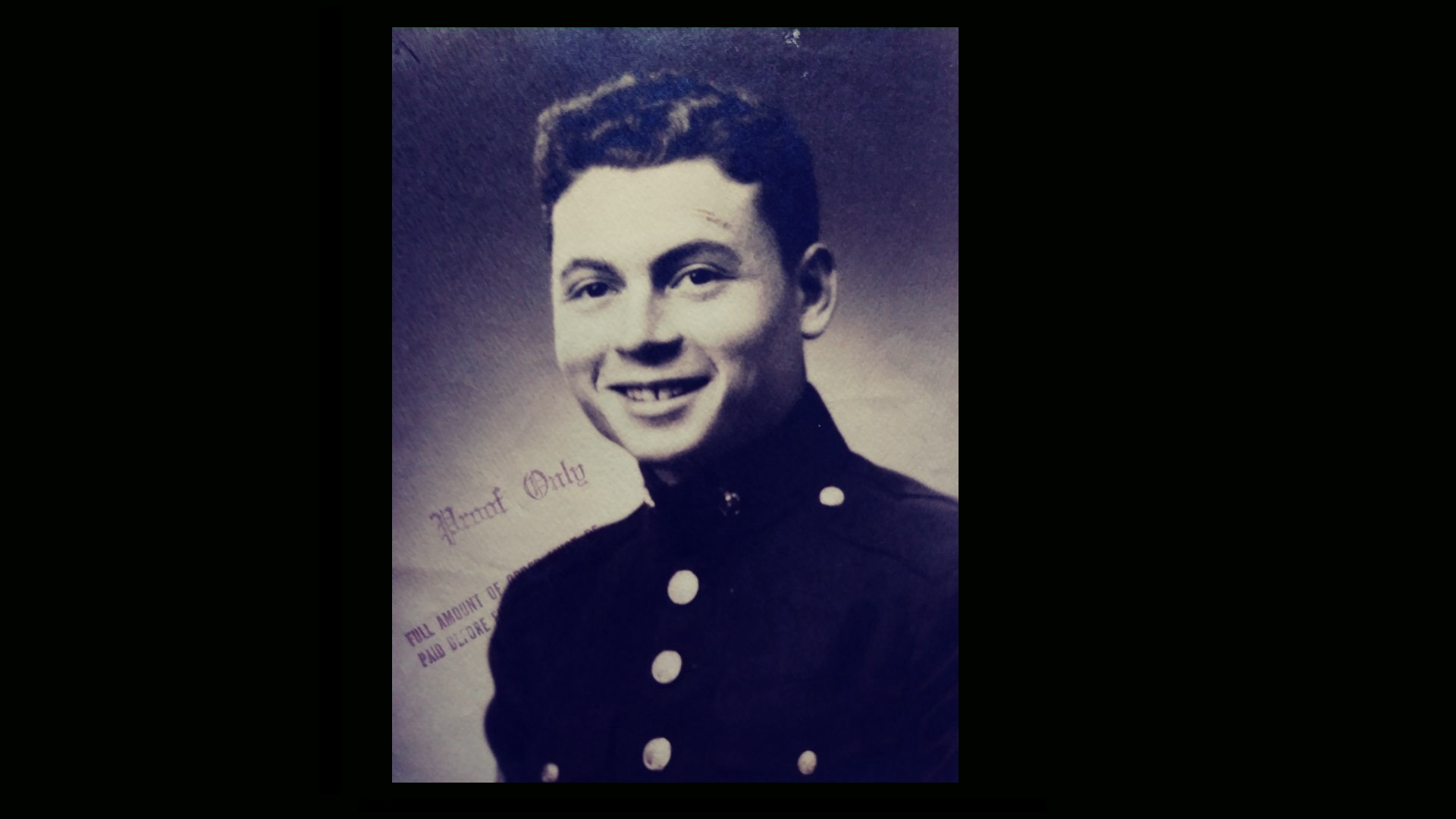
Victor Carrabotta in the service mid-1940’s
Stan looked at the letter and I said, Mr. Lee, would you like to see my work? He says no, Jack says you’re a good artist he
says he says, here, I want this back in the week. The first story i ever did was the House on the Hill.”
A.C. Hollingsworth
Alvin Carl Hollingsworth aka A.C. Hollingsworth was one of the first black artists in comic books during the 1940s and 1950s. He is known for his unusual style which found its way onto some of the most sought after pre-code comic titles today.
SHOW IMAGES OF HOLLINGSWORTH COVERS.
Matt Baker
One of the most famous comic book artists of the time who also happened to be black was the great Matt Baker. Baker became famous for his superb renditions of the female form in romance comics and famous heroine titles like the costumed crimefighter Phantom Lady, but his work was also used often in Fawcett’s landmark pre-code horror comic, VOODOO, when he worked for Jerry Iger’s IGER SHOP.
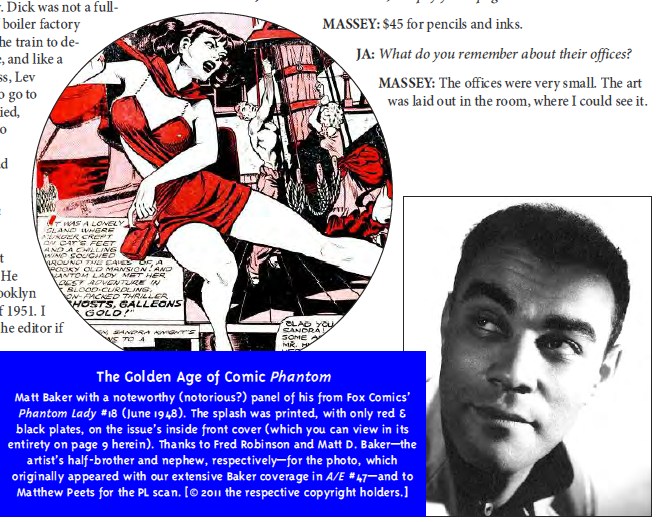
Comic Book artist Matt Baker
While many of his stories were simply reprints from 1940’s comics, the addition of the Baker art made Fawcett’s VOODOO a sought after title that demands big bucks in today’s collectors market.
Bernard Baily
Famously known as the co-creator of DC Comics THE SPECTRE and HOURMAN, Bernard Baily’s pre-code horror covers and interior art for STANLEY MORSE and WEIRD MYSTERIES remain some of the coolest covers in the history of pre-code. Baily had a way of demanding attention from the customer, and I can imagine any comic fan seeing one of his titles in the local comic shop had to have it.
Star Publications
Star Publications came out of left field with a series of stunning covers by the publisher himself, German born L.B. Cole, with strange and cool interior art by the unique talents of Jay Disbrow. Today, these comics sell as fast as just about any other pre-code titles as their value continues to climb through the decades.
Basil Wolverton
Famous for his hilariously insane art in MAD MAGAZINE, Basil Wolverton cut his considerable teeth on pre-code horror comics doing stories for WEIRD TALES FROM THE FUTURE, another remarkable title from Stanley Morse. Wolverton’s wild interior art easily matched his outrageous covers creating memorable issues that are highly sought after today.
Jack Kirby
Of course, Jack Kirby made his name at Marvel in the 1960s, but few know that Kirby did covers and interior work for Prize Publications’ BLACK MAGIC series, and you can see the genius slowly emerging 10 years before he brought us super heroes like the FANTASTIC FOUR.
Steve Ditko
Another famous artist from the Marvel bullpen is Steve Ditko who rose to fame with Spider-Man beginning with Amazing Fantasy #15 in 1962. The cover was pencilled by Jack Kirby and inked by Ditko. Ditko began the Amazing Spider-man comic book series with Stan Lee.
Like many other artists who went on to Marvel and DC, Ditko started doing covers and interiors for pre-code comics in the early 1950s, most famously for Charlton Comics featuring titles like The Thing and This Magazine is Haunted. He also did interiors for Farrell Publication’s Strange Fantasy and Fantastic Fears.
Bernard Baily
Much like Bernard Baily with The Spectre during the 1940s, artist Jack Cole was famous for creating the unusual superhero Plastic Man for Quality Comics beginning in 1943. During the horror heyday of the pre-code 50s, Cole did some unforgettable art for Quality Comics’ Web of Evil including the fantastic issue #5 depicting a lauging man in an electric chair, one of the most sought after Jack Cole pre-code covers. It is important to note that Cole’s 1947 story for True Crime Comics called “Murder, Morphine and Me” became a prime example of psychiatrist Dr. Fredric Wertham ‘s anti comic book crusade during the ’50s. Sadly, Jack Cole took his own life in 1958, a few years after the comics code authority took effect. (insert shot of jack cole)
Matt Fox
The unusual and fantastic art of Matt Fox first graced the covers of Weird Tales magazine from 1943 to 1951. His style was at once primitive and unique giving the pulp magazine some of its greatest covers. Right after his run with Weird Tales, Matt Fox turned in some stellar covers and artwork for Youthful Comics’ famous title, Chilling Tales. He also provided art for Atlas comics’ World of Fantasy, Tales of Suspense, and Journey into Mystery.
Lee Elias and Warren Kremer
Ask any pre-code collector and they will tell you that Lee Elias did some of the most iconic covers in horror comic history. That being said, he had a bit of help from his mentor and boss, Warren Kremer. Kremer was editor at Harvey Comics when Lee Elias started out and he quickly took the young artist under his wing. In many cases, Kremer did a rough sketch for a cover and Elias drew the final version. These covers from Harvey’s Black Cat Mystery, Chamber of Chills, and Tomb of Terror represent some of the most sought after comics in pre-code horror today, a few of them fetching many thousands of dollars in excellent condition. But Warren Kremer also did some of the art himself as evidenced by the gorgeous and haunting cover of Black Cat Mystery #37 featuring a woman sleep walking through a cemetery of ghouls.
Jerry Iger’s IGER SHOP
In the world of pre-code horror comics, Jerry Iger’s IGER SHOP was the super-factory, churning out dozens of comics a month for a variety of publishers. Certain artists would do specific things like penciling, inks, colors, and even particular parts of stories like buildings or people, etc., and it was all done at such a rapid pace that the quality would sometimes suffer because of it, but there is no denying that IGER SHOP were the juggernauts of the era.
Artists who worked for Iger Shop include Robert Webb, Maurice Gutwirth, Ken Battefield, Jay Disbrow, and Matt Baker. To this day, who did what on certain comics is hotly contested and seems to change on a yearly basis, but these artists contributed to titles like HAUNTED THRILLS, FANTASTIC FEARS, STRANGE FANTASY, VOODOO, JOURNEY INTO FEAR, MYSTERIOUS ADVENTURES, and more.
Ruth Roche
One thing we do know is that Jerry Iger’s right hand man was in reality a woman, one of the few females who worked in pre-code comics. RUTH ROCHE edited many of the IGER SHOP titles and actually wrote a lot of the stories contained within.
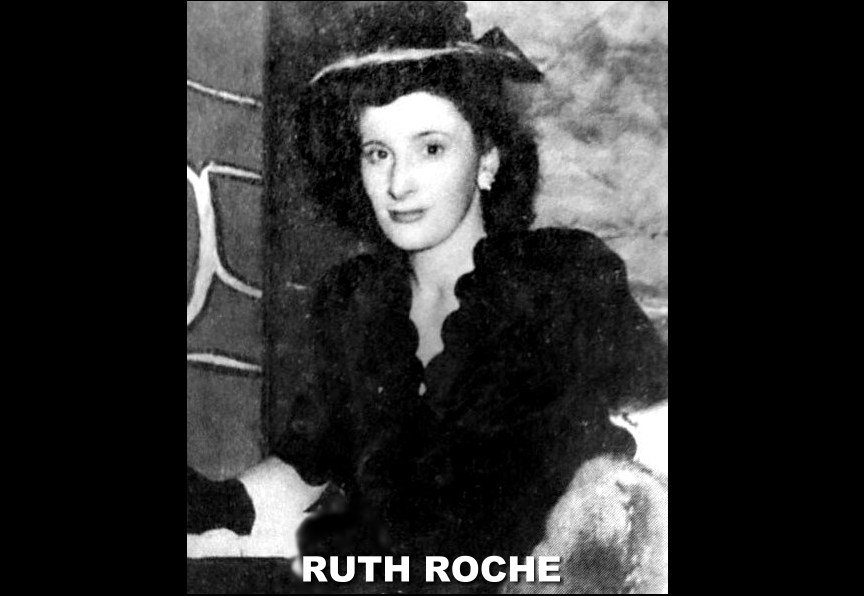
Ruth Roche Iger Shop editor and writer
.
In my feature film WITCH TALES, I adapted one of Ruth Roche’s stories called “Experiment in Terror” about a mad doctor who ponders the question, “Is love greater than hunger?”
Witch Tales features three pre-code horror tales hosted by a seductive witch on Halloween night, and was my own love letter to the awesome pre-code horror comic books of the 1950s.
I hope you’ve enjoyed this little terror tour of a bygone era whose current popularity proves that the fans’ love for pre-code comics will never die.
Watch the entire HAUNTED THRILLS documentary here.
